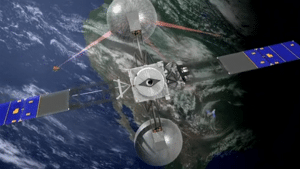Latest News
[Via Satellite 10-02-2015] BridgeSat, a startup satellite operator focusing on optical connectivity, is planning a network of SmallSats and ground stations designed to aid other small satellites in beaming data down from Low Earth Orbit (LEO). The company is part of the portfolio of Allied Minds, a U.S. science and technology development and commercialization company, and has partnerships with nonprofits The Aerospace Corporation and Draper Laboratory to make its proposed satellite system a reality.
Formed in March 2015, BridgeSat is commercializing optical communications technology from The Aerospace Corporation. The proposed network would focus on relaying data from Earth Observation (EO) and other remote sensing spacecraft that often produce high quantities of content. John Serafini, co-general manager of BridgeSat, told Via Satellite the company has a two-stage plan for creating the network.
“BridgeSat’s first phase focuses on secure, high-bandwidth data transmission via an optical downlink system. This system includes a compact, low-power optical transmitter that can fit nearly any sized satellite as well as a series of BridgeSat optical ground control stations,” he said. “With the BridgeSat system, customers have hundreds of Mbps of bandwidth per satellite, allowing maximum utilization of the satellite’s capacity.”
In September, BridgeSat reached an agreement with Draper to develop the ground control stations. Draper-developed technology will be implemented in the system for operations, task automation, and efficient data delivery. The space segment is to follow, with a constellation of about 50 relay nodes currently planned for around 2018.
“In the second phase, BridgeSat plans to nearly eliminate downlink latency by launching a constellation of relay satellites that can quickly transport a satellite’s data to the ground even when a ground control station is not within view. With low latency data downlink, operators will have access to their satellite’s data moments after it is captured, enabling a host of new applications for time-sensitive data,” said Serafini.
BridgeSat’s ground control system uses infrastructure that is significantly more compact than a traditional Radio Frequency (RF) system. Serafini said this is because the ground optical receiver is detecting a pulsed laser from the transmitting satellite, so the required detector is much smaller than an RF receiver. The tracking of the ground receiver must be extremely precise in order to detect the satellite’s optical transmission, he said.
The technology will have challenges from weather, as cloud cover can block optical beams, forcing the satellite network to reroute through cross-links to sunnier locations with accessible ground stations. Serafini said BridgeSat currently does not plan to create new terrestrial fiber infrastructure to support its ground network, and that the company is in the process of evaluating the number and location of ground stations.
Though atmospheric interference poses a challenge, BridgeSat is confident that the pros of the laser system outweigh the cons. The Aerospace Corporation has been working on advances in CubeSat technologies, particularly in lasers and in attitude determination and control, for more than three years. Richard Welle, director of microsatellite systems at The Aerospace Corporation, told Via Satellite that they realized the opportunity to commercialize this technology “when it became obvious that we would be able to demonstrate communication at data rates above 100 Mbps rather than the 5 Mbps that was originally proposed.”
Discussions with Allied Minds, led to the concept being pursued today. The Aerospace Corporation, having supplied much of the technology base, will continue to support technology development, including building and flying prototype satellites, Welle said.
In addition to providing laser communications for SmallSats, BridgeSat will also market its optical system to users of high-altitude Unmanned Aerial Vehicles (UAVs). Often deployed for Information, Surveillance and Reconnaissance (ISR), UAVs can create high quantities of data that needs to be uplinked. The Aerospace Corporation also envisions using the technology for deep space missions. Serafini said BridgeSat is evaluating different bus configurations for its satellites today. He declined to quantify how much data the constellation will be able to handle, but said that the optical system will initially offer hundreds of Mbps for each satellite, moving to multi-Gbps bandwidth over the next several years.
The Aerospace Corporation’s Optical Communication and Sensor Demonstration (OCSD) mission directly influences BridgeSat’s connectivity system. NASA’s Space Technology Mission Directorate (STMD) is supporting the two-CubeSat mission, which is scheduled to take place this year.
“The first version, scheduled for launch in October is expected to provide communication at rates between 100 and 200 Mbps. The second version, scheduled to fly in early 2016, is expected to reach 622 Mbps. We’ve started work on a version aimed at 2.5 Gbps. Additional evolutionary stages will include longer ranges and bi-directional communication,” said Welle.
As The Aerospace Corporation continues to improve upon the technology, BridgeSat could also reap the benefits.
Get the latest Via Satellite news!
Subscribe Now